A History of the County of Buckingham: Volume 4. Originally published by Victoria County History, London, 1927.
This free content was digitised by double rekeying. All rights reserved.
'Parishes : Haversham', in A History of the County of Buckingham: Volume 4, ed. William Page (London, 1927), British History Online https://prod.british-history.ac.uk/vch/bucks/vol4/pp366-372 [accessed 23 April 2025].
'Parishes : Haversham', in A History of the County of Buckingham: Volume 4. Edited by William Page (London, 1927), British History Online, accessed April 23, 2025, https://prod.british-history.ac.uk/vch/bucks/vol4/pp366-372.
"Parishes : Haversham". A History of the County of Buckingham: Volume 4. Ed. William Page (London, 1927), British History Online. Web. 23 April 2025. https://prod.british-history.ac.uk/vch/bucks/vol4/pp366-372.
In this section
HAVERSHAM
Havresham (xi cent.); Haveresham, Haversam, Heveresham (xii–xiii cent.); Horsham, Haresham (xvii cent.).
This parish contains about 1,623 acres, of which about 929 are permanent grass, 584 arable, and 6 woods and plantations. (fn. 1) The soil is mixed; the chief crops are wheat, oats and beans. The highest ground is in the north-east, where it is about 332 ft. above the ordnance datum; but on the borders of the parish, by the Ouse and its tributary, the land is more than 100 ft. lower and liable to floods.
The viaduct of the London and North Western railway crosses the south-west of the parish.
The village, which lies in the south-east, consists of houses scattered along the road from Wolverton to Little Linford. A group of buildings at the south end of the village street comprises the church, rectory and schools. The manor-house with the remains of a moat lies to the south of the church. It is a stone house of two stories with a tiled roof, and dates in part from the last half of the 17th century. A considerable portion of the house was demolished in 1792 (fn. 2) and a new wing was added on the northeast two years later. Some of the windows have been blocked and others altered. In the grounds is a square dovecote of stone with a tiled roof which bears the date 1665 and the initials M.T., standing for Maurice Thompson, who purchased the manor in the preceding year. Near the dovecote is a fish-pond. Haversham Grange, about a quarter of a mile north-east of the church, probably represents the grange of the Abbot of Lavendon, who in the 15th century held a grange called 'Grenesden' at the rent of a pound of pepper, payable to the lord of the manor. (fn. 3) The present house, a gabled stone building with tiled roofs, seems to have been built in the early 17th century, the date 1628 with the initials T/TE appearing on one of the gables. The plan consists of a block facing north-west, which contains the entrance, and a large wing at the south-west. Some 14th-century details, possibly survivals from the original grange, are incorporated in the structure. These include the pointed entrance doorway on the north-west front, a similar doorway inside between the main block and the south-west wing, a window of two trefoiled lights lighting the ground floor at the north-east end of the house, and a small square-headed window in the ground story of the south-west wing.
Some Roman remains have been found in the parish. (fn. 4)
The house of George Martin at Haversham was licensed for Presbyterian worship in 1672. (fn. 5)
Old field-names include Ruggemore in the 13th century, (fn. 6) Kytlecrofte, Kachewyn, Shurlok in the 15th century, (fn. 7) Great and Little Coale Stocking, Woad Stocking, Ffoulkes Stocking, Foddering Yard and Dry Closes, in the 18th century. (fn. 8)
An Inclosure Act for the parish was passed in 1764. (fn. 9)
Manors
Before the Conquest the manor of HAVERSHAM was held by Countess Gueth, wife of Earl Ralf of Hereford. (fn. 10) In 1086 it was assessed at 10 hides and was held by William Peverel himself. (fn. 11) It was afterwards attached as one fee to his honour of Peverel, and so remained, the last mention of this overlordship occurring in 1525. (fn. 12)
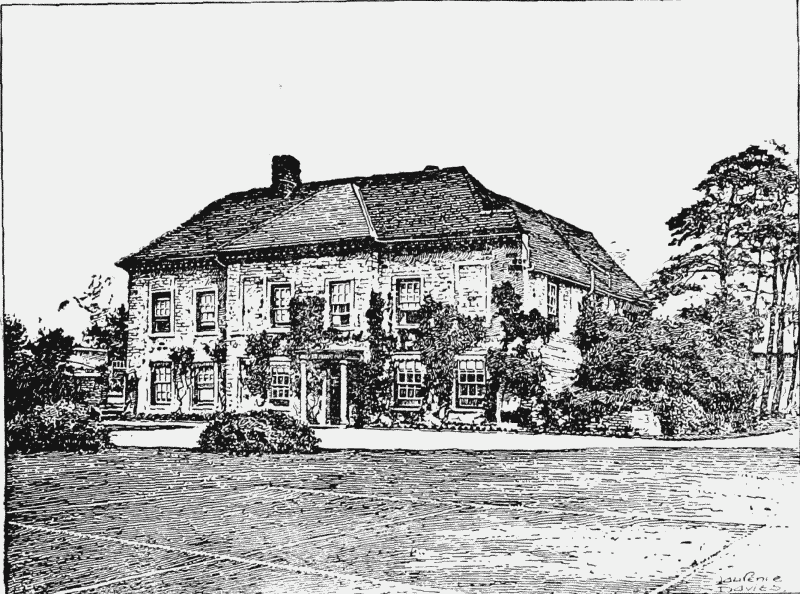
The Manor House, Haversham
The tenants who held Haversham in the 12th century took their name from the place. Robert and Nicholas de Haversham are mentioned in 1174–7. (fn. 13) In 1190 Hugh de Haversham rendered account of 30 marks for an agreement concerning the wood of Haversham. (fn. 14) Hugh held Haversham as late as 1220. (fn. 15) His son Nicholas owed 100s. for relief for his father's fee here in 1221. (fn. 16) Nicholas de Haversham, who in 1232 was one of the collectors of the one-fortieth in the county, (fn. 17) held Haversham until his death about 1251, (fn. 18) when he was succeeded by a son of the same name. (fn. 19) This Nicholas died in 1274, leaving a daughter and heir Maud, who was then only six months old, (fn. 20) and a widow Joan, to whom dower was assigned in the manor. (fn. 21) In 1274, during Maud's minority, the bailiff of the king's escheator was accused of selling the timber and destroying a fish-pond there. (fn. 22) About this time the custody of the manor was granted to Queen Eleanor. (fn. 23) Maud daughter of Nicholas married as her first husband James de la Plaunche, who was seised of the manor in the right of his wife until his death about 1306. (fn. 24) He left two sons: John, the elder, (fn. 25) who seems to have died young, and William, who afterwards held the manor. (fn. 26) His widow married John de Olney (fn. 27) before 1309, (fn. 28) and in 1324 a settlement was made by which Haversham was to pass after Maud's death to William de la Plaunche and Joan his wife and their issue, with contingent remainders to John son of John de Olney and Maud de Haversham and his issue, to John and James sons of John de Pabenham, the husband of Joan de la Plaunche, daughter of James and Maud, and their issue successively. (fn. 29) Maud outlived her second husband, (fn. 30) and died about 1329, when William de la Plaunche inherited. (fn. 31) He married a second wife, Hawise, and died about 1335, leaving a son William, then aged nearly ten. (fn. 32) Roger Hillary and John Leghe were guardians in 1346. (fn. 33) In 1347 William died, leaving two daughters Katherine and Joan, aged four and two, while a third, Elizabeth, was born after his death. (fn. 34) By 1356 Joan was dead, Katherine had married William de Birmingham, and Elizabeth five years later was the wife of John son of Fulk de Birmingham. (fn. 35) Katherine seems to have died without issue sometime after 1372, when a second inquisition was held as to her father's property, (fn. 36) and Elizabeth was seised of the whole by 1389, when she was the wife of John Lord Clinton. (fn. 37) She afterwards married Sir John Russell, kt., (fn. 38) and various settlements of the manor were made, it being at this period invariably in the hands of trustees, and known as PLANCHES or PLANKUS MANOR. (fn. 39) She left no issue at her death in 1423, her heir being William Lucy, the son of Alice, daughter of Margery, daughter of James son of Joan de Pabenham. (fn. 40) The manor, however, was claimed under the terms of the settlement of 1324 by Walter de Strickland and Isabel his wife, who was the daughter and heir of John de Olney, son of William, son of John, son of John de Olney and Maud de Haversham. (fn. 41) Their claim was upheld, and the manor was quitclaimed to them in 1429 by the trustees of Elizabeth Russell, with reversion, failing Isabel's issue, to Alice Lucy and her issue. (fn. 42) Isabel died in 1445. (fn. 43) Her son and heir Richard Strickland was a minor, and the manor was again in the hands of trustees. (fn. 44) He attained his majority, however, before his death in 1458. (fn. 45) Since he left no issue Haversham passed, under the terms of the fine of 1429, to William Lucy, (fn. 46) as it was found by inquisition that Alice mother of William Lucy had died in 1430. (fn. 47) William died in 1466, and his son William, who succeeded him, (fn. 48) also acquired Dagnall Manor in Edlesborough and Great Loughton Manor, with the latter of which Haversham descended. During the tenure of William Lucy, great-greatgrandson of the William who died in 1466, (fn. 49) Richard Ylshaw, who claimed to hold a lease of Haversham lordship, was ordered in 1541 not to molest Thomas Oldney in his possession of the farm of Haversham lordship until the case between the two was decided. (fn. 50) William Lucy denied that he had ever promised the farm to Oldney, as the latter maintained, but was advised to reflect that, as the king had written to him in Oldney's favour, it would be well to let him have the farm and recompense Ylshaw some other way, a course which he ultimately followed. (fn. 51) Sir Thomas Lucy, kt., son of William, did not alienate Haversham with Loughton Manor in 1557, but, with Thomas his son, (fn. 52) made a settlement of the manor in 1580. (fn. 53) Sir Thomas's chief claim to fame lies in his alleged prosecution of Shakespeare about 1585 for deer-stealing in the Lucys' park at Charlecote, Warwickshire, which led to the poet's immortalizing Lucy in the character of Justice Shallow. (fn. 54) He made a further settlement of Haversham in 1594, (fn. 55) and died in 1600, (fn. 56) his son Thomas dying in 1605. (fn. 57) Thomas, son and heir of the latter, succeeded to Haversham, (fn. 58) dying in 1640. (fn. 59) He was followed by his eldest son Spenser Lucy, whose widow, with her second husband William Sheldon, (fn. 60) quitclaimed the manor in 1653 to Robert Lucy, (fn. 61) brother and heir of Spenser. (fn. 62) Robert's brother and male heir Richard held in 1660, (fn. 63) but appears to have become deeply involved in debt and mortgaged the property to John Corrance, who held with others in 1664. (fn. 64) It was apparently sold in that year to Maurice Thompson, 'a Person of mean Extraction,' (fn. 65) who was sheriff of the county in 1669, (fn. 66) and died in 1671, being succeeded by his son John, (fn. 67) upon whom he had settled Haversham Manor in 1668. (fn. 68) John Thompson was created a baronet in 1673, (fn. 69) and was raised to the peerage as Lord Haversham in 1696. (fn. 70) He was member for Gatton, Surrey, in 1685, and was among the heartiest partisans of William of Orange. (fn. 71) He was made a lord of the Admiralty in 1699, but resigned two years later, and went over to the Tory party. As a member of the House of Lords he was instrumental in making that assembly persistently reject the Occasional Conformity Bill. In 1705 he achieved notoriety by moving the address to the queen urging her to call to England Sophia of Brunswick, the heir-presumptive. This was in effect the close of his public career. He died in 1710, and was succeeded by his son Maurice, the second Lord Haversham. (fn. 72) He held the Haversham estate (fn. 73) until 1729, when he joined with his daughters in selling it for £24,500 to Lucy Knightley, (fn. 74) who was descended, on his mother's side, from the Lucy family who had previously held Haversham. (fn. 75) He died in 1738, leaving a son and heir Valentine, (fn. 76) who was succeeded in 1754 by his son Lucy. (fn. 77) In 1764 he barred the entail, (fn. 78) and in the same year sold to the trustees of Alexander Small. (fn. 79) In the Northants Mercury for September 1764 appeared an advertisement that Small, as owner of the manor of Haversham, 'being desirous to preserve the Game and Fishery in the said Manors (i.e., Clifton, Hardmead and Haversham) for his own and Friends' Amusement, gives this public Notice, that all unqualified Persons who shall hereafter be found guilty of disturbing, killing or destroying the Game . . . shall be prosecuted by the utmost Rigour of the Law.' (fn. 80) He was at this time about seventeen, and was married, having one child. He is described in a contemporary record as 'a great Sportsman and much given up to amorous Dalliances, as reported, so as to occasion great Uneasinesses at Home.' (fn. 81) His son Alexander was party to a deed in 1785, the object apparently being to break the entail; the son, however, died during his father's lifetime. (fn. 82) In 1806 Small sold the manor to Roger Radcliffe and William Greaves. (fn. 83) By a deed of 1815 it was assigned to the latter, (fn. 84) in whose family it has since remained, Mr. Thomas Greaves being now lord of the manor.
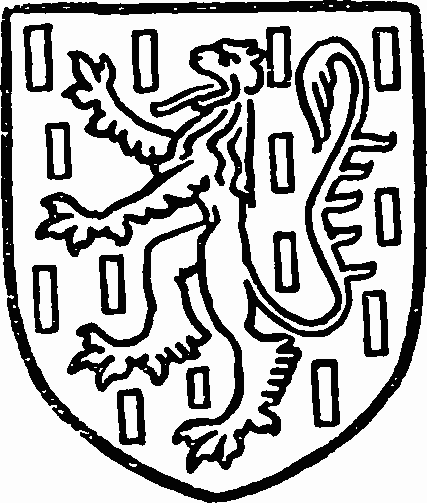
De La Plaunche. Argent billety and a lion sable.
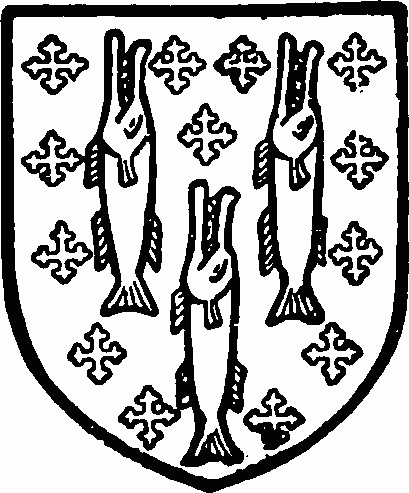
Lucy. Gules crusilly with three luces argent.
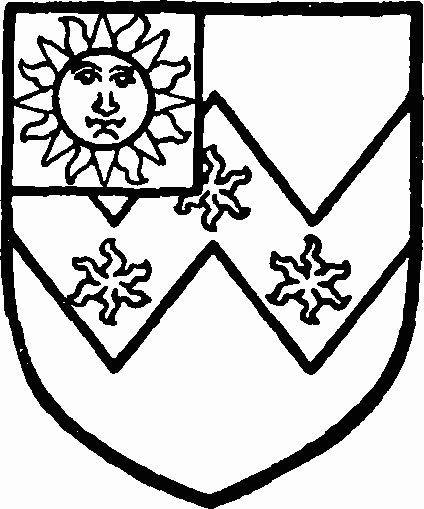
Thompson, Lord Haversham. Or a fesse dancetty azure with three stars argent thereon and a quarter azure charged with a sun or.
The capital messuage of the manor is mentioned in 1273 as being worth, with dovecote, grange, garden and vineyard, 30s. per annum. (fn. 85) In 1304 the lord of the manor received licence to crenellate his dwelling-place of Haversham. (fn. 86) Part of the dower assigned to Hawise widow of William de la Plaunche in 1335 included part of the manor-house—namely, the great chamber with the chapel at the head of it beyond the door of the hall, the maids' chamber with the gallery (oriola) leading from the hall to the great chamber, the said door into the hall to be shut at the will of Hawise; also the painted chamber next the great chamber, with a wardrobe; a dairy-house with the space between the dairy and the door into the great kitchen, which door could be shut at Hawise's pleasure; the new stable with the house called the cart-house, a grange called the Kulnhouse, a third part of the dovecote, &c. (fn. 87)
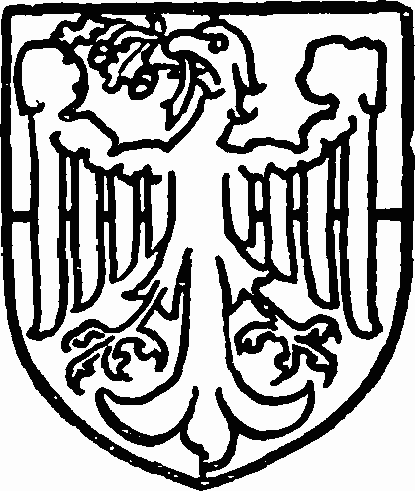
Greaves. Quarterly gules and vert an eagle holding in his beak a slip of oak all or.
A mill was among the appurtenances of the manor in 1086, when it was worth 8s. and seventy-five eels. (fn. 88) The water-mill was held with the manor, and is mentioned in many of the deeds and inquisitions relating to that property. Rentals of the manor in the 15th century show that Haversham Mill was then invariably worth 66s. 8d. per annum to the lord. (fn. 89) At this time there was also a second water-mill in the parish, called Helwall Mill or the New Mill, where the Prior of Bradwell had a fishery. (fn. 90) In 1619 two water gristmills existed here, (fn. 91) but only one is mentioned in 1764. (fn. 92)
In 1273 the lord of the manor had a fishery worth 8s. (fn. 93) A free fishery in the Ouse belonged to the manor in 1278–9 (fn. 94) and so continued, as late as the 17th century. (fn. 95)
A park is mentioned in 1207, when Benedict de Haversham quitclaimed to Hugh de Haversham all common of pasture for his beasts which he had or claimed in Hugh's park. (fn. 96) Nicholas de Haversham received a grant of free warren in his demesne lands here in 1233, (fn. 97) in virtue of which grant free park and warren were claimed in 1278–9. (fn. 98) In 1309 the park is referred to as having been broken into, (fn. 99) but there appears to be no further record of it, although Sir Thomas Lucy received a grant of free warren in 1618. (fn. 100)
The estate afterwards known as the manor of BELAUNEY or BOLNEYS consisted of 90 acres in 1278–9, when it was held by Sir John de Haversham of Baldwin de Belauney (Bello Aneto), who held of the main manor. (fn. 101) From 1335 to 1342 the fourth part of a knight's fee in Haversham was held by Richard de Belauney and extended at £4 yearly. (fn. 102) In 1369 Walter de Miltecoumbe quitclaimed the fourth part of Haversham Manor to Fulk de Birmingham, (fn. 103) whose son John married Elizabeth de la Plaunche (vide supra). Elizabeth made a settlement of this manor in 1389, (fn. 104) and at her death in 1423 was found to hold the manor called 'Belneys' under the name of a fourth part of Haversham Manor. (fn. 105) Under the terms of a settlement Bolneys Manor remained to John Russell, clerk, son of Sir John Russell, kt., her last husband, and his issue. (fn. 106) Robert Russell died seised of it in 1502, (fn. 107) and his son John sold it to William Lucy in 1533, (fn. 108) after which this estate doubtless became again amalgamated with the main manor.
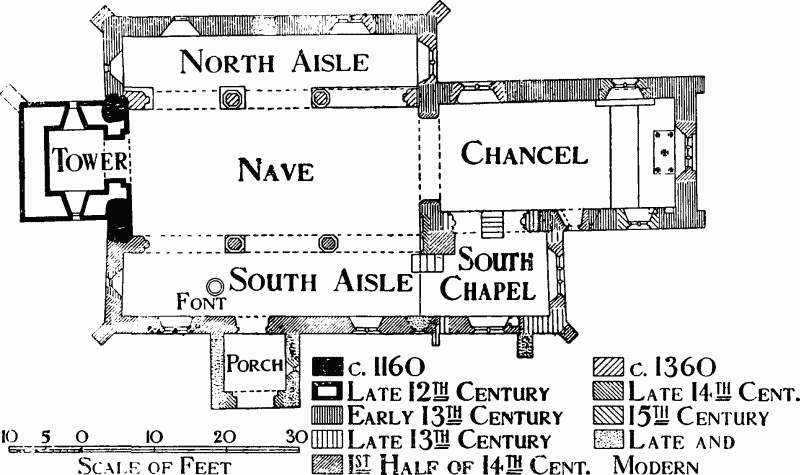
Plan of Haversham Church
Church
The church of ST. MARY consists of a chancel 32 ft. 11 in. by 15 ft. 2 in., south chapel continuous with the south aisle 11 ft. 10 in. wide, nave 40 ft. 3 in. by 17 ft. 9 in., north aisle 7 ft. 9 in. wide, south aisle 8 ft. 9 in. wide, west tower 7 ft. 9 in. by 8 ft. 5 in., and a south porch 8 ft. by 8 ft. 6 in. These measurements are all internal.
The west wall of the nave, in which is an original window of the latter half of the 12th century, is the only surviving fragment of a church of that period, consisting, doubtless, of a nave and chancel. Before the close of the century the existing west tower was added, and early in the succeeding century the chancel was rebuilt, eastward apparently of the former chancel, and north and south aisles were thrown out on either side of the extended nave. The south chapel seems to have been originally erected at the end of the 13th century, but it was entirely remodelled in the first half of the 14th century, when the south arcade and aisle were rebuilt, the new arcade being placed outside the line of the original south wall of the nave. Later in the same century the north arcade was also rebuilt, and about 1400 the south porch was added. In the 15th century the clearstory was constructed, the pitch of the original roof being lowered. A restoration was undertaken in 1857, and again in 1903, when the tower was thoroughly repaired. The walls are of rubble masonry and the roofs are leaded.
In the east wall of the chancel is a 14thcentury window of three trefoiled ogee lights with reticulated tracery in a twocentred head. At the east end of the north wall, and probably contemporary with the late 14th-century tomb recess beneath it, is a window of two cinquefoiled lights with quatrefoil tracery within a two-centred head. At the opposite end of the wall is a window of two elliptical-headed trefoiled lights with a two-centred head filled with leaf tracery; the window is of about 1360 and of the same work as the east and north-east windows of the north aisle. At the south-east is a square aumbry rebated for a door, and immediately to the west of it is a piscina with an acutely pointed chamfered head; the basin appears to have originally projected from the niche, but has been subsequently cut back flush with the wall face. The two windows in the eastern portion of the wall are insertions of the early 15th century; each is square-headed and of two lights with ogee heads, those of the eastern window being cinquefoiled, while the lights of the western window are trefoiled. Below the latter is a 14th-century doorway with a two-centred external head moulded continuously with the jambs. The remainder of the wall is occupied by a late 13thcentury arch opening to the south chapel; the arch is two-centred and of two chamfered orders and the responds are formed of three clustered and engaged shafts with moulded capitals. The bases have been cut away, probably for fixing a parclose screen, and the capitals have also been cut into for the same purpose. The chancel arch, which was evidently rebuilt in the 14th century, is two-centred and of two chamfered orders, the outer order segmental and continuous, and the inner order dying into the plain responds. Externally the eastern angles of the chancel are finished with angle rolls, and there are dwarf buttresses, with their outside angles similarly treated, at either end of the east wall, all work of the early 13th century.
The north arcade of the nave dates from about 1360 and is of three bays with two-centred arches of two chamfered orders carried by octagonal columns with moulded capitals and bases. The inner order springs from semi-octagonal responds at either end of the arcade, the outer order being continuous. On the nave face the arches are inclosed by labels terminating in volutes over the east and west responds, and having head-stops over the columns. The south arcade is of the same number of bays, and has arches and columns of the same form, but the capitals and bases are of an earlier and more refined section, and there are no labels. The inner order is carried upon the east respond by a moulded corbel with a 'liripipe'-like termination. To the south of the chancel arch is a large late 14th-century niche with a subfoliated trefoiled head, which probably contained the painted reredos of a nave altar; immediately to the south of it, beneath the respond corbel of the south arcade, is a smaller and narrower niche with a cinquefoiled head and foiled spandrels, doubtless connected with the same purpose. High up in the west wall, above the tower arch, is the 12th-century window above referred to, a small round-headed light with wide internal splays, and a round rear-arch moulded with an angle roll and inclosing cheveron continued upon the edges of the jambs. The 15th-century clearstory windows, three on either side, are all square-headed, and each is of two cinquefoiled lights, the heads of the lights of the south-east window being square.
The east and north-east windows of the north aisle are similar to the north-west window of the chancel, and, like it, are coarse copies of the beautiful south windows of the opposite aisle and chapel. In the middle bay of the north wall, visible only externally, is a blocked early 13th-century doorway with a chamfered two-centred head springing from defaced impost mouldings and inclosed by a label. At the west end of the wall is a small lancet of the same period with an external glass rebate and a flat internal head with widely splayed jambs. In the west wall is a similar but smaller lancet. The diagonal buttresses at the eastern and western angles of the aisle are probably additions of the 14th century.
The east window of the south chapel is squareheaded and of three lights; the opening may be of the 14th century, but the head and mullions are evidently late work, probably of the 17th century. The south window, which is of two trefoiled lights with leaf-tracery in a two-centred head, is valuable as an example of the very best type of 14th-century design. The grotesque stops of the external label are specially noteworthy for the delicacy of their carving. In the east jamb is an angle piscina with two ogee-headed trefoiled openings, each inclosed by a moulded label; the basin is now covered by the raised floor upon which the organ stands. The windows in the first and third bays of the continuous south aisle are of the same design, but their labels are without carved stops. Immediately to the west of the buttress which marks the junction of the aisle and chapel is a small blocked 14th-century doorway with a two-centred external head inclosed by a moulded label and moulded continuously with the jambs. The south doorway in the middle bay of the wall has a head of the same form, and is of two continuously moulded orders. In the west wall is an early 13th-century lancet with a moulded external label. The small narrow buttress at the junction of the aisle and chapel is of a different character from those at the east and west angles, and is probably contemporary with the original building of the chapel. The masonry of the walling round the south window of the chapel has been greatly disturbed, probably when the window was inserted, and a large modern buttress has been erected to the east of the window, where the wall bulges considerably.
The south porch appears to have been almost entirely rebuilt at some period with the old materials, as all the detail looks as though reset. The outer entrance has a chamfered two-centred head, and in the east wall is a small trefoiled light with a fragmentary square label above it.
The late 12th-century tower arch is two-centred and is recessed in two plain orders on the nave side. The impost mouldings from which it springs, and the label, are restored. The ground stage is lighted from the north by an original lancet; the window in the south wall now has a square head, but the opening is probably original. Externally the tower rises in three receding stages and is crowned by an embattled parapet. The intermediate stage has no windows, but the bell-chamber is lighted from each side by a window of two round-headed lights contained within an external order with an unpierced head of the same form.
The roofs are modern. The font is of the late 14th century, and has an octagonal bowl and stem with panelled sides. Fifteen 16th-century seats and two desk fronts are preserved in the nave. In the east window of the south chapel are some fragments of 15th-century glass. The pulpit, and a communion table in the south chapel, are of the 17th century.
At the north-east of the chancel is a remarkably fine alabaster tomb and recess of the late 14th century. (fn. 109) Upon the tomb, which projects slightly from the recess, is a recumbent female effigy wearing a coverchief upon the head and a pleated widow's barbe; over her dress is a sideless côte covered by a long mantle fastened across the breast by a cord from which hangs a tassel. The hands are joined in prayer, and the head rests upon a pillow held up by angels, while at her feet is a lion. The cornice of the tomb is enriched with four-leaved flowers, and the front has six panels with trefoiled heads, separated from each other by small pinnacled buttresses and having leafcarved spandrels. The two middle panels contain male 'weepers' in the civil dress of the period, while in the remaining panels on either side are angels holding blank shields. The head of the recess is formed by a large two-centred arch, continuously moulded with the jambs, and having pierced cinquefoiled cusping, each foil of which is subfoliated. The arch is inclosed by a crocketed ogee canopy, flanked by panelled and pinnacled buttresses, and rising above the sill of the window over the recess. On the south wall of the chancel is a brass, with a figure, commemorating Alice Payn (d. 1427). The inscription is as follows: 'Hic iacet Alicia Payn Nuper uxor Thome Payn | Armigeri que obiit in die Commemoracionis animarum | anno dñi m°cccc°xxvij cujus anime propicietur deus Amen.' In the chancel floor is a brass commemorating John Mansell (d. 1605–6). The brass is engraved with a skeleton lying in a coffin, and two shields, both bearing a cheveron between three maunches with a crescent for difference. The following is the inscription: 'Here resteth the body of Iohn Maunsell Gent: | who departed this life the 25th of Ianuarye | 1605 when he had lived LXVI yeeres fower | moneths and five dayes whose Christian life | and godly end god graunt us all follow.' On the north wall of the chancel is a tablet to Anne Mackerness (d. 1765), and to her husband, John Mackerness, rector of Haversham (d. 1775).
There is a ring of three bells: the treble by Anthony Chandler, 1667; the second, inscribed 'God Save Our King 1625 I.K.,' by James Keene; and the tenor by the same and bearing the same inscription, but with the date 1638. There is also a sanctus bell dated 1752.
The plate includes a cup and cover paten of 1569, a plated cup and paten and a modern flagon.
The earliest surviving volume of registers contains baptisms from 1665, marriages from 1685, and burials from 1670.
Advowson
A presentation to Haversham Church was made in 1221 by the lord of the manor, (fn. 110) to which the advowson remained attached until the 19th century. (fn. 111) In 1828 Alexander Small's trustees presented Henry Alexander Small, (fn. 112) who afterwards obtained the patronage, holding until about 1856. The Rev. A. B. Frazer then became both incumbent and patron, and so remained until 1889, when the Rev. B. L. Symonds obtained the living and is now the patron.
In 1309 the parson of the church complained that the lord of the manor and others had assaulted and imprisoned him, and had forbidden the inhabitants of the parish to give him tithes, fire or water, or to speak to him, and had also greatly damaged his lands, crops and cattle. (fn. 113) A later rector, in 1357, received pardon for having killed William Golde, bailiff of Newport Pagnell, in self-defence. (fn. 114)
A rent-charge for the support of a light in the church is mentioned as early as the 13th century. (fn. 115) In the 16th century it was found that land worth 3s. per annum had been given for this purpose. (fn. 116)
There do not appear to be any endowed charities subsisting in this parish.